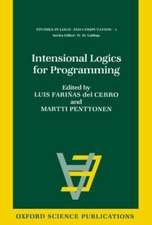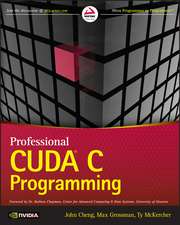Guide to Assembly Language: A Concise Introduction: Undergraduate Topics in Computer Science
Autor James T. Streiben Limba Engleză Paperback – 24 ian 2020
This updated second edition has been expanded with additional exercises, and enhanced with new material on floating-point numbers and 64-bit processing.
Topics and features: provides guidance on simplified register usage, simplified input/output using C-like statements, and the use of high-level control structures; describes the implementation of control structures, without the use of high-level structures, and often with related C program code; illustrates concepts with one or more complete program; presents review summaries in each chapter, together with a variety of exercises, from short-answer questions to programming assignments; covers selection and iteration structures, logic,shift, arithmetic shift, rotate, and stack instructions, procedures and macros, arrays, and strings; includes an introduction to floating-point instructions and 64-bit processing; examines machine language from a discovery perspective, introducing the principles of computer organization. A must-have resource for undergraduate students seeking to learn the fundamentals necessary to begin writing logically correct programs in a minimal amount of time, this work will serve as an ideal textbook for an assembly language course, or as a supplementary text for courses on computer organization and architecture. The presentation assumes prior knowledge of the basics of programming in a high-level language such as C, C++, or Java.
| Toate formatele și edițiile | Preț | Express |
|---|---|---|
| Paperback (2) | 337.25 lei 6-8 săpt. | |
| Springer International Publishing – 24 ian 2020 | 337.25 lei 6-8 săpt. | |
| SPRINGER LONDON – 15 aug 2014 | 416.41 lei 6-8 săpt. |
Din seria Undergraduate Topics in Computer Science
- 20%
 Preț: 272.43 lei
Preț: 272.43 lei - 20%
 Preț: 233.75 lei
Preț: 233.75 lei - 20%
 Preț: 318.97 lei
Preț: 318.97 lei - 20%
 Preț: 306.58 lei
Preț: 306.58 lei - 20%
 Preț: 187.22 lei
Preț: 187.22 lei - 20%
 Preț: 316.24 lei
Preț: 316.24 lei - 20%
 Preț: 280.92 lei
Preț: 280.92 lei - 20%
 Preț: 287.02 lei
Preț: 287.02 lei - 20%
 Preț: 305.61 lei
Preț: 305.61 lei - 20%
 Preț: 258.78 lei
Preț: 258.78 lei - 20%
 Preț: 371.61 lei
Preț: 371.61 lei - 20%
 Preț: 246.39 lei
Preț: 246.39 lei - 20%
 Preț: 330.42 lei
Preț: 330.42 lei - 20%
 Preț: 316.07 lei
Preț: 316.07 lei - 20%
 Preț: 384.11 lei
Preț: 384.11 lei - 20%
 Preț: 245.43 lei
Preț: 245.43 lei - 20%
 Preț: 306.71 lei
Preț: 306.71 lei - 20%
 Preț: 350.89 lei
Preț: 350.89 lei - 20%
 Preț: 336.99 lei
Preț: 336.99 lei - 20%
 Preț: 374.37 lei
Preț: 374.37 lei - 20%
 Preț: 225.02 lei
Preț: 225.02 lei - 20%
 Preț: 226.64 lei
Preț: 226.64 lei - 20%
 Preț: 375.53 lei
Preț: 375.53 lei - 20%
 Preț: 395.04 lei
Preț: 395.04 lei - 20%
 Preț: 307.16 lei
Preț: 307.16 lei - 20%
 Preț: 179.87 lei
Preț: 179.87 lei - 20%
 Preț: 254.37 lei
Preț: 254.37 lei - 20%
 Preț: 192.73 lei
Preț: 192.73 lei -
 Preț: 334.88 lei
Preț: 334.88 lei - 20%
 Preț: 342.45 lei
Preț: 342.45 lei - 20%
 Preț: 276.82 lei
Preț: 276.82 lei - 20%
 Preț: 237.35 lei
Preț: 237.35 lei - 20%
 Preț: 374.20 lei
Preț: 374.20 lei - 20%
 Preț: 304.44 lei
Preț: 304.44 lei - 20%
 Preț: 297.28 lei
Preț: 297.28 lei - 20%
 Preț: 227.15 lei
Preț: 227.15 lei - 20%
 Preț: 579.37 lei
Preț: 579.37 lei - 20%
 Preț: 298.18 lei
Preț: 298.18 lei - 20%
 Preț: 243.35 lei
Preț: 243.35 lei - 20%
 Preț: 302.80 lei
Preț: 302.80 lei - 20%
 Preț: 297.66 lei
Preț: 297.66 lei - 20%
 Preț: 300.89 lei
Preț: 300.89 lei - 20%
 Preț: 191.35 lei
Preț: 191.35 lei - 20%
 Preț: 278.10 lei
Preț: 278.10 lei - 20%
 Preț: 304.21 lei
Preț: 304.21 lei - 20%
 Preț: 389.96 lei
Preț: 389.96 lei - 20%
 Preț: 429.00 lei
Preț: 429.00 lei - 20%
 Preț: 281.40 lei
Preț: 281.40 lei
Preț: 337.25 lei
Preț vechi: 421.56 lei
-20% Nou
Puncte Express: 506
Preț estimativ în valută:
64.54€ • 66.100$ • 53.82£
64.54€ • 66.100$ • 53.82£
Carte tipărită la comandă
Livrare economică 22 martie-05 aprilie
Preluare comenzi: 021 569.72.76
Specificații
ISBN-13: 9783030356385
ISBN-10: 3030356388
Pagini: 344
Ilustrații: XV, 344 p. 612 illus., 35 illus. in color.
Dimensiuni: 155 x 235 x 23 mm
Greutate: 0.55 kg
Ediția:2nd ed. 2020
Editura: Springer International Publishing
Colecția Springer
Seria Undergraduate Topics in Computer Science
Locul publicării:Cham, Switzerland
ISBN-10: 3030356388
Pagini: 344
Ilustrații: XV, 344 p. 612 illus., 35 illus. in color.
Dimensiuni: 155 x 235 x 23 mm
Greutate: 0.55 kg
Ediția:2nd ed. 2020
Editura: Springer International Publishing
Colecția Springer
Seria Undergraduate Topics in Computer Science
Locul publicării:Cham, Switzerland
Cuprins
Variables, Registers, and Data Movement.- Input/Output.- Arithmetic Instructions.- Selection Structures.- Iteration Structures.- Logic, Shifting, Rotating, and Stacks.- Procedures and Macros.- Arrays.- Strings.- Floating-Point Instructions.- 64-bit Processing.- Selected Machine Language Instructions.- Appendix A: Directions for MASM in Visual Studio 2019 Community Edition.- Appendix B: Binary, Hexadecimal, Logic, and Arithmetic.- Appendix C: Glossary.- Appendix D: Selected Assembly Language Instructions.- Appendix E: Answers to Selected Exercises.
Notă biografică
Dr. James T. Streib is Professor Emeritus of Computer Science at Illinois College, Jacksonville, IL, USA. His other publications include the Springer textbooks Guide to Data Structures and Guide to Java.
Textul de pe ultima copertă
This concise guide is designed to enable the reader to learn how to program in assembly language as quickly as possible. Through a hands-on programming approach, readers will also learn about the architecture of the Intel processor, and the relationship between high-level and low-level languages.
This updated second edition has been expanded with additional exercises, and enhanced with new material on floating-point numbers and 64-bit processing.
Topics and features:
Dr. James T. Streib is Professor Emeritus of Computer Science at Illinois College, Jacksonville, IL, USA. His other publications include the Springer textbooks Guide to Data Structures and Guide to Java.
This updated second edition has been expanded with additional exercises, and enhanced with new material on floating-point numbers and 64-bit processing.
Topics and features:
- Provides guidance on simplified register usage, simplified input/output using C-like statements, and the use of high-level control structures
- Describes the implementation of control structures, without the use of high-level structures, and often with related C program code
- Illustrates concepts with one or more complete program
- Presents review summaries in each chapter, together with a variety of exercises, from short-answer questions to programming assignments
- Covers selection and iteration structures, logic, shift, arithmetic shift, rotate, and stack instructions, procedures and macros, arrays, and strings
- Includes an introduction to floating-point instructions and 64-bit processing
- Examines machine language from a discovery perspective, introducing the principles of computer organization
Dr. James T. Streib is Professor Emeritus of Computer Science at Illinois College, Jacksonville, IL, USA. His other publications include the Springer textbooks Guide to Data Structures and Guide to Java.
Caracteristici
Readers will very quickly learn how to begin programming in assembly language Provides a hands-on approach that will enable readers to learn about the computer architecture of the Intel 32-bit processor, and the relationship between high-level and low-level languages Illustrates the key concepts of each chapter with complete programs, chapter summaries, and exercises, supported by further material in the Appendices Updated second edition featuring new material on floating point operations
Recenzii
From the reviews:
“The well-organized book is divided into ten chapters and five appendixes. The ten chapters follow a fairly standard layout for a book on this language, with each chapter concluding with a summary section and an appropriate set of exercises … . Summing Up: Recommended. All readership levels.” (J. Beidler, Choice, Vol. 49 (2), October, 2011)
“It teaches assembly language with precision and verve, and it also provides the reader with some understanding of the computer architecture that drives assembly language. … This book is an excellent text for a course in assembly language programming, and for programmers who want to understand the low-level operations and constructs that underlie high-level languages. Its attention to machine issues also makes it suitable as a supplemental text in a course on computer operations or architecture.” (Marlin Thomas, ACM Computing Reviews, August, 2011)
“The well-organized book is divided into ten chapters and five appendixes. The ten chapters follow a fairly standard layout for a book on this language, with each chapter concluding with a summary section and an appropriate set of exercises … . Summing Up: Recommended. All readership levels.” (J. Beidler, Choice, Vol. 49 (2), October, 2011)
“It teaches assembly language with precision and verve, and it also provides the reader with some understanding of the computer architecture that drives assembly language. … This book is an excellent text for a course in assembly language programming, and for programmers who want to understand the low-level operations and constructs that underlie high-level languages. Its attention to machine issues also makes it suitable as a supplemental text in a course on computer operations or architecture.” (Marlin Thomas, ACM Computing Reviews, August, 2011)












